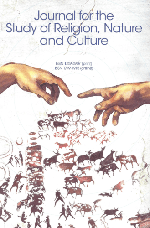The latest issue of the JSRNC, Vol. 11, No 1 is out now. The theme of this latest Special Issue is Religion and Eco-Resistance Movements in the Twenty-First Century.
In their introduction to this special issue Bron Taylor and Joseph Witt write:
The last decade of the twentieth century was a pivotal era in global environmental activism. North American radical groups such as Earth First!, the Earth Liberation Front, and the Sea Shepherd Conservation Society had gained international media attention and influenced public perception of environmental problems. Environmental themes infused popular Western culture through children’s television shows like Captain Planet and the Planeteers and films such as Fern Gully (Kroyer 1992). Meanwhile, scientists from around the world increasingly warned about human impacts on biodiversity and the global climate. Heeding the warnings of scientists and the requests of an increasingly concerned public, some high-profile politicians called for environmental policy reforms. For example, Al Gore, the US Vice President throughout much of the 1990s, made passionate appeals for global policy changes aimed at addressing burgeoning ecological crises. His book Earth in the Balance (Gore 1992) sold enough copies to earn a position on the New York Times bestseller list and a later film documenting his educational efforts surrounding climate change, An Inconvenient Truth (Guggenheim 2006), won an Academy Award. By the end of the 1990s, while global environmental problems continued to proliferate, a robust response also seemed to be emerging among stakeholders from around the world … In many ways the social and ecological context as we write this introduction is similar to 1995, except that now, our environmental predicaments are all the more dire and obvious. So as predicted in the previous effort, it seems likely that religion-infused ecological resistance movements will continue to emerge and battle for the well-being of people and the diverse environments they inhabit. This issue of the JSRNC further illuminates these trends and poses the question as to whether these movements, despite their great diversity and the forces arrayed against them, might be able to gain significant victories and momentum in time to avert their worst fears.
Below is a summary of the content from this issue, with links to the content on the Equinox website for those with online membership.
Table of Contents
Introduction
Articles
Field Notes












